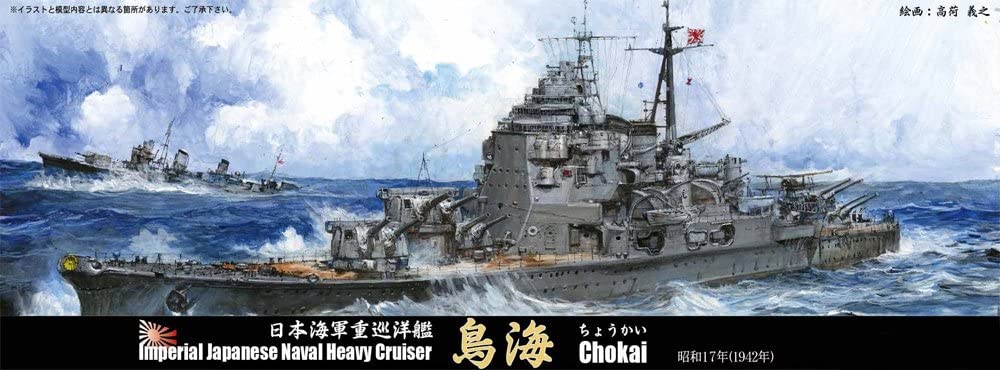
I wanted to make a heavy cruiser once in a while, so I got a kit of Fujimi’s Chokai. Etched parts are also available, so I will replace the ones I can.
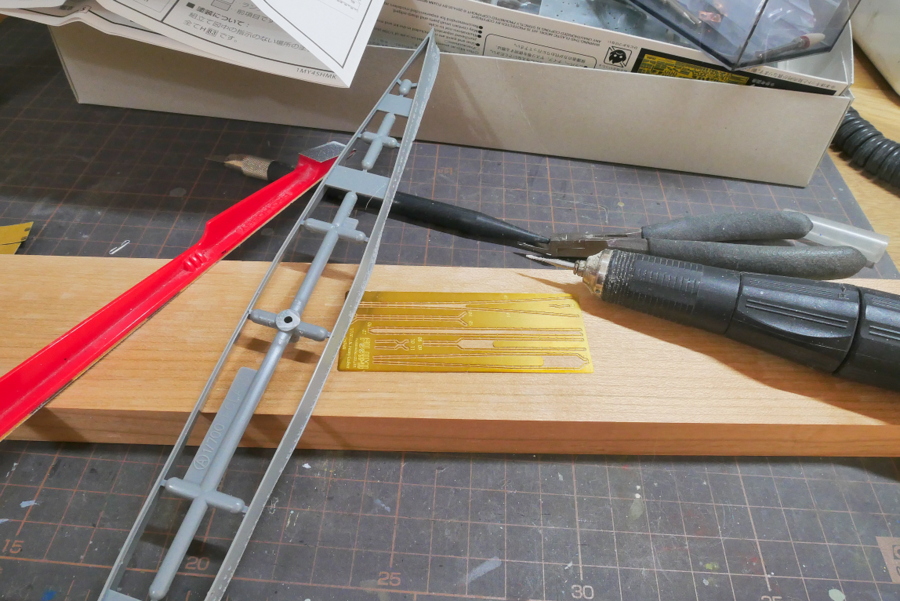
I was surprised to start with an explanation that I should cut all the molds of the degaussing line on the side and install the etched parts. I attached a very thin engraving cutter to the tip of the electric luter and shaved it lightly. This work is hard. If you use a paper file, the round window frame will be shaved. And it won’t work well. I will try to use photo-etched parts since I have already prepared them. If it is troublesome, I think plastic mold is fine and does not do this work.
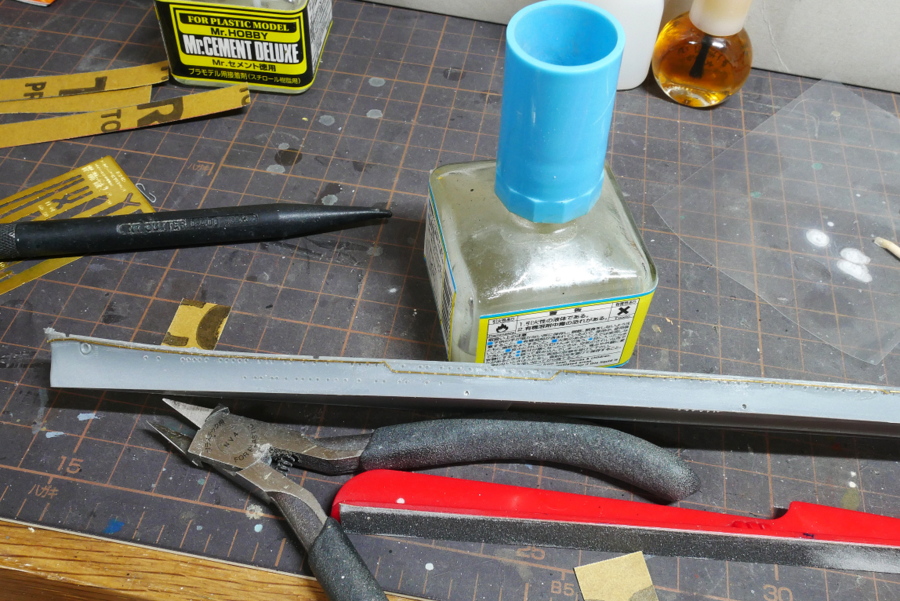
Etched parts installation of the degaussing line is a difficult task. I don’t know how it feels, but I have attached it. I built about ten ships so that I may get out of the beginner, but this is hard. It doesn’t work very well, but the work itself is interesting.
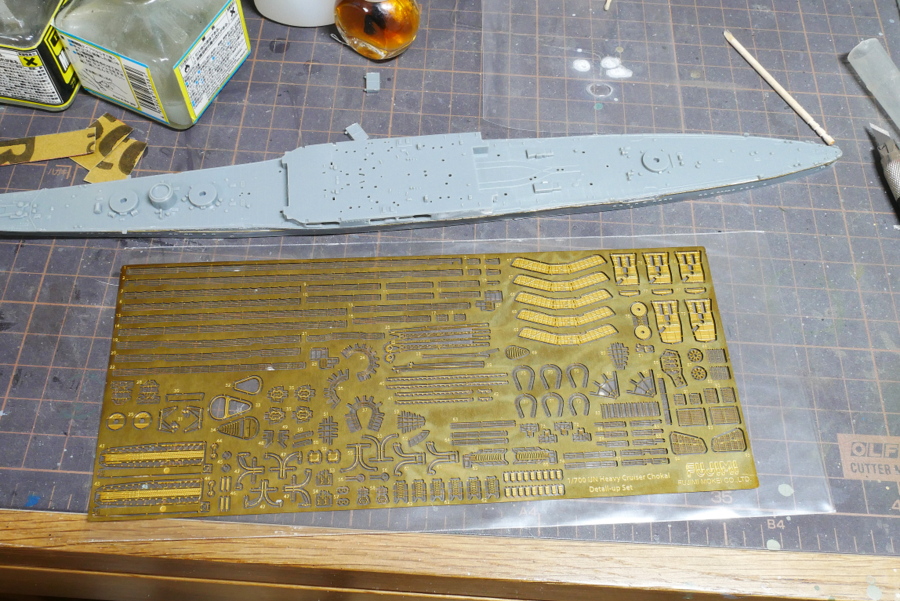
I’m not good with etched parts because they are detailed, but I don’t feel like I’m making a ship model without them these days. At first, I was satisfied with only the handrail. I always put too much super glue and get it dirty. I don’t think this part is available now. That’s too bad. Since this is the case, I think it’s not wrong to pile them up. Well, I can’t take many plastic models to the grave.
(2021/05/20)

There are many holes in the deck. Are those all going to be installed on the structure of the ship? I feel like I’m going to build a small town.
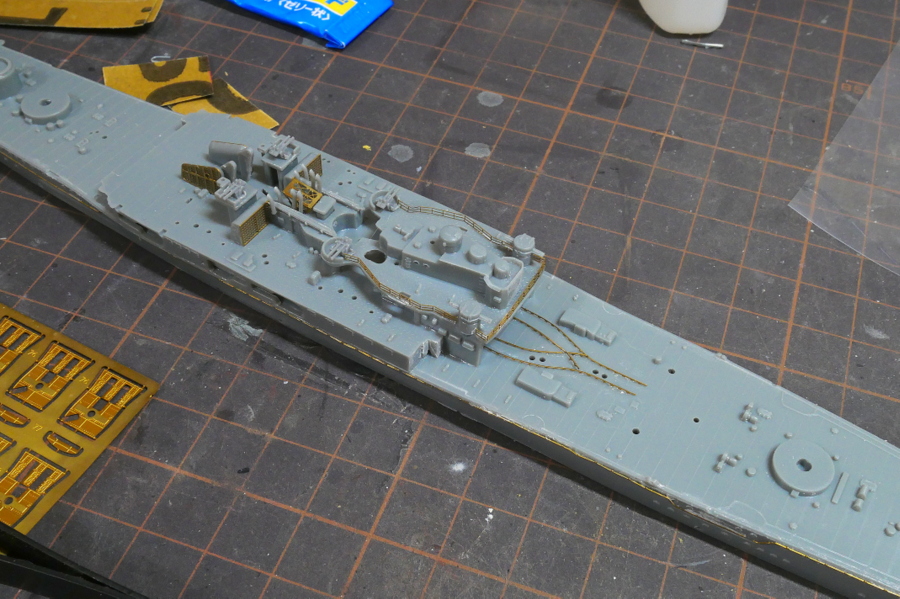
The ones that seem to be challenging to attach to the etched parts later were attached earlier.
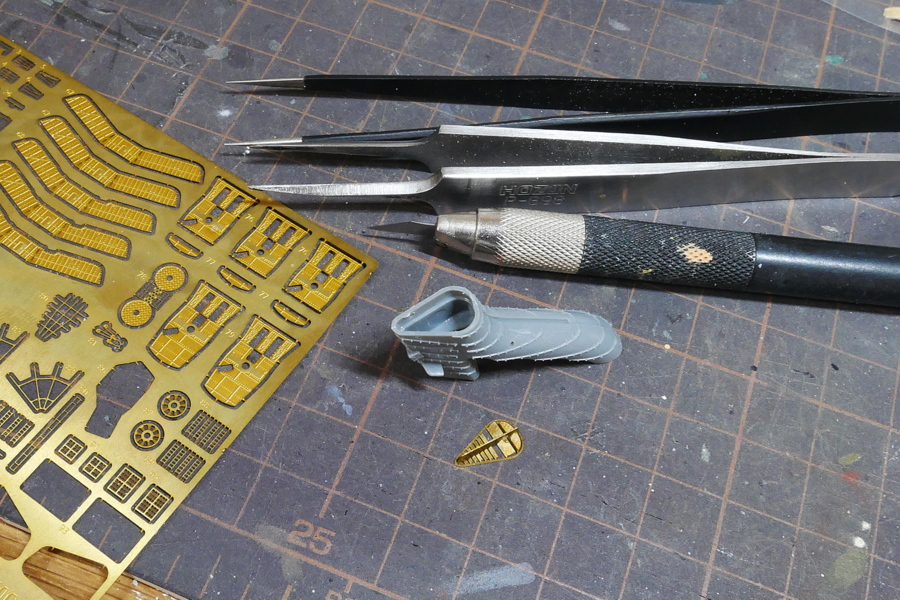
Where the etched parts of the chimney vent are incorporated, I’m nervous because I have to bend at a delicate angle.
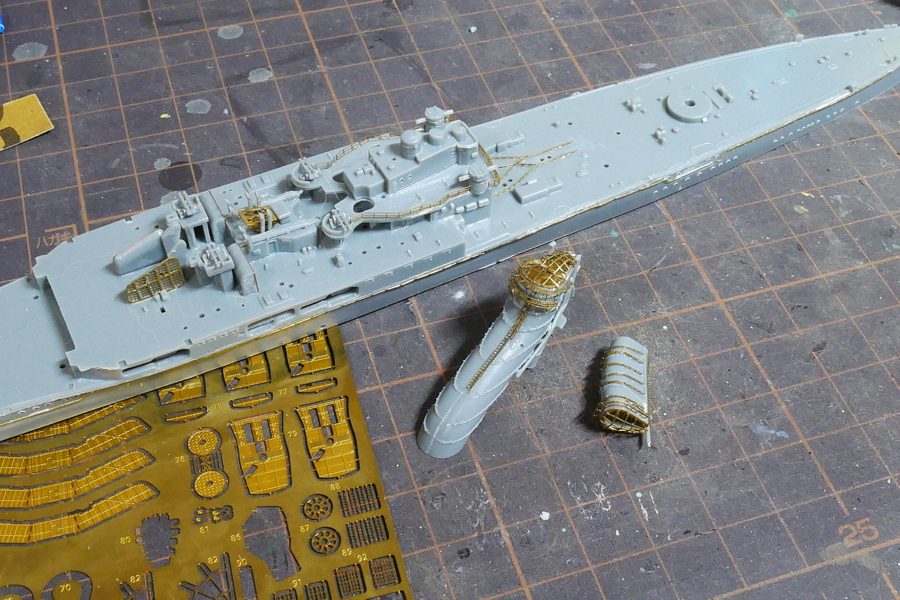
Etched parts are used for various small parts, such as chimneys. There is something like an exhaust vent that I don’t quite understand. Is this OK? There was such a place.
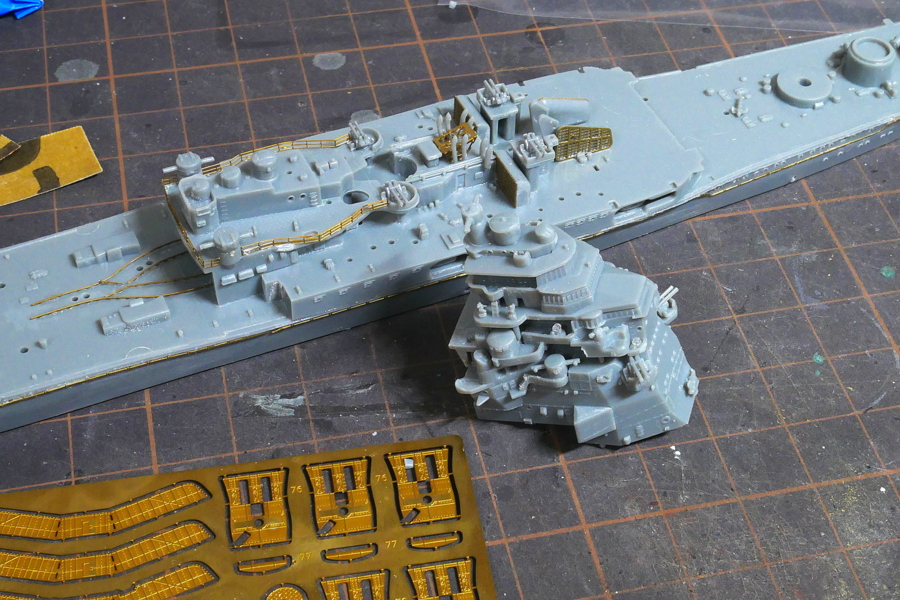
The bridge has no parts to replace with etched parts; many handrails will be added later. There won’t be a problem if you don’t think about the detailed procedure.
(2021/05/22)

I tried to fix it on the paint stand to prevent damage. With this kit, bonding the first chimney and the bridge to the hull is quite tricky. In an earlier stage, the glued parts interfered with each other and did not fit well. It was hard to see where the interference was.
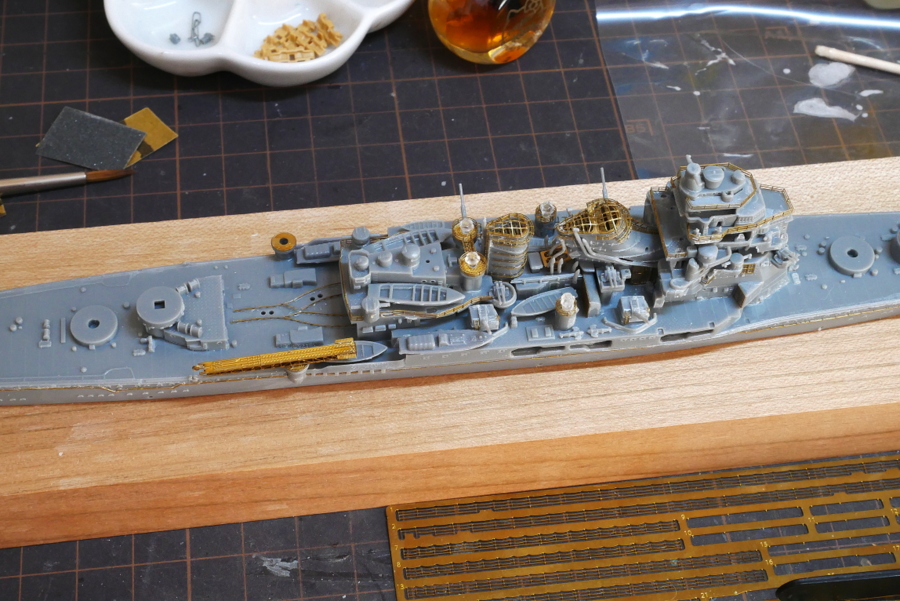
The structure of the ship’s upper part, the bridge, the chimney, and the searchlight stand has been built gradually. When the plastic parts of the catapult base are attached to the hull, the etched parts of the outer-side electrical circuit interfere and do not fit properly. I will put it on correctly and fill the gap later, but the other side doesn’t fit well even if I cut off the etched parts and attach the catapult base. It just seems that the parts didn’t fit well. This Chokai kit doesn’t fit that well. It is pretty tricky to assemble.
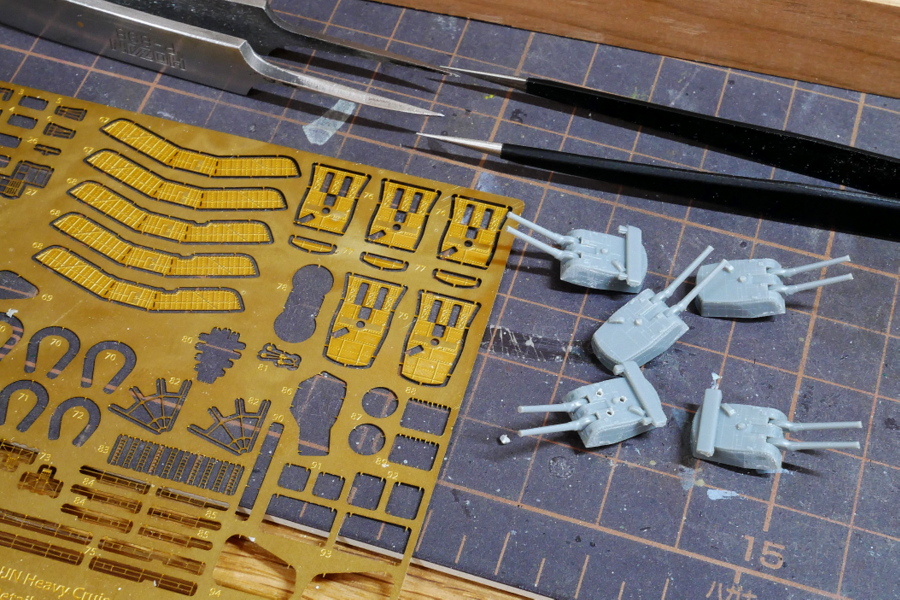
Fujimi’s Etched Parts have different points to focus on depending on the kit, from my little experience in the past. It seems that flashy large etched parts are used for the main gun. Why? Are they trying to improve the mold? Well, replace what I can.
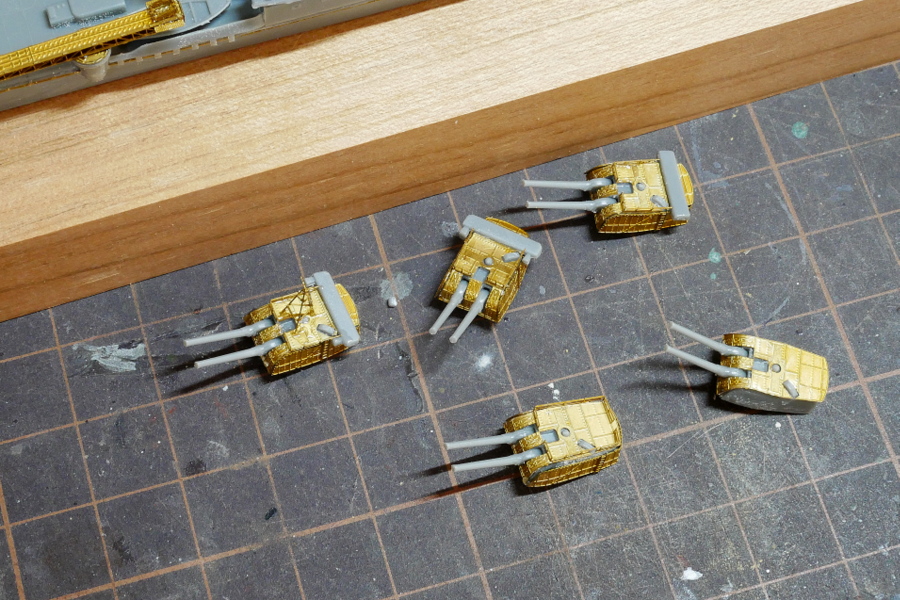
I struggled to assemble these etched parts, putting them on the main gun plastic parts. The main gun has a handrail on the ceiling and a ladder on the side.
(2021/05/25)
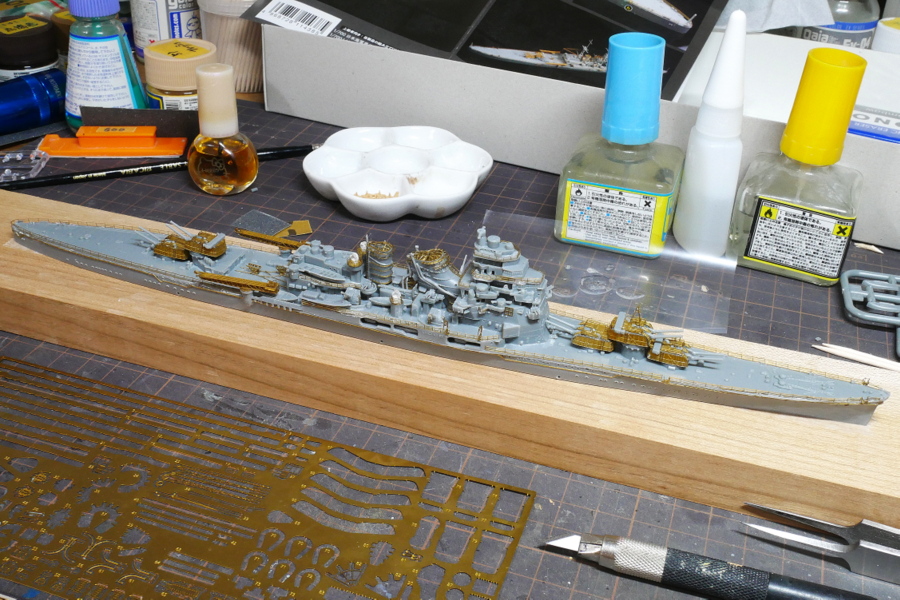
This time, I attached the small boats and the cutter boat first. The small boat takes more space than I thought. When I tried to install the steps of the etched parts after the adhesion of the boats, there was no place, and I forcibly installed them. Because I can paint the wood part from above, there are quite a lot of them, so if you glue them first, they will be cleared up.
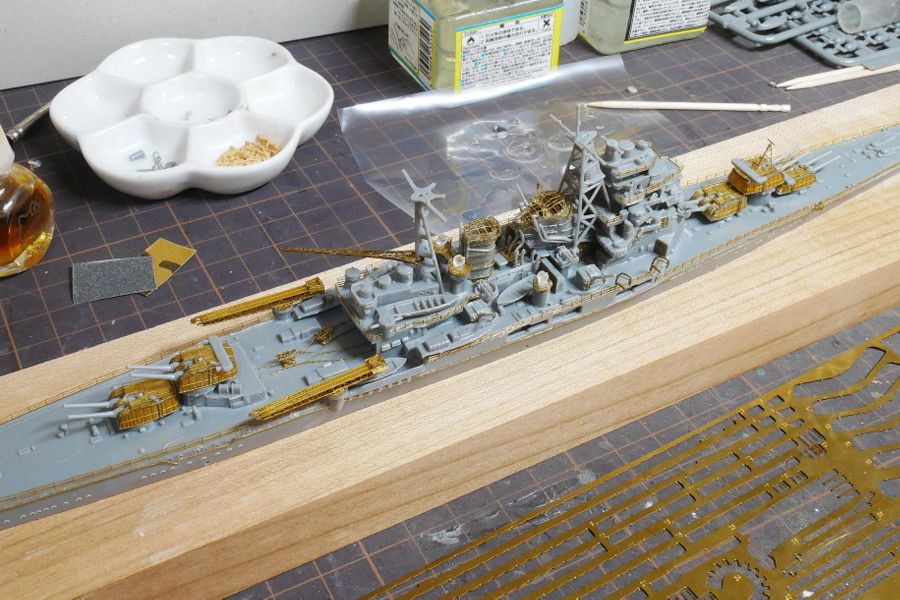
When the foremast was inserted between the bridge and the chimney to be glued together, the etched parts attached to the chimney fell off and irritated me. When the handrail was bent and bonded, it was cut off, and if it was held in tweezers, it flew away, and it was irritating, and the model ship would not be suitable unless the person were patient. Or maybe we don’t care too much. It might work out if I add another part to the broken handrail. The whole thing looked better when I started to attach the mast. This kit is a little hard to assemble. It’s surprisingly challenging.
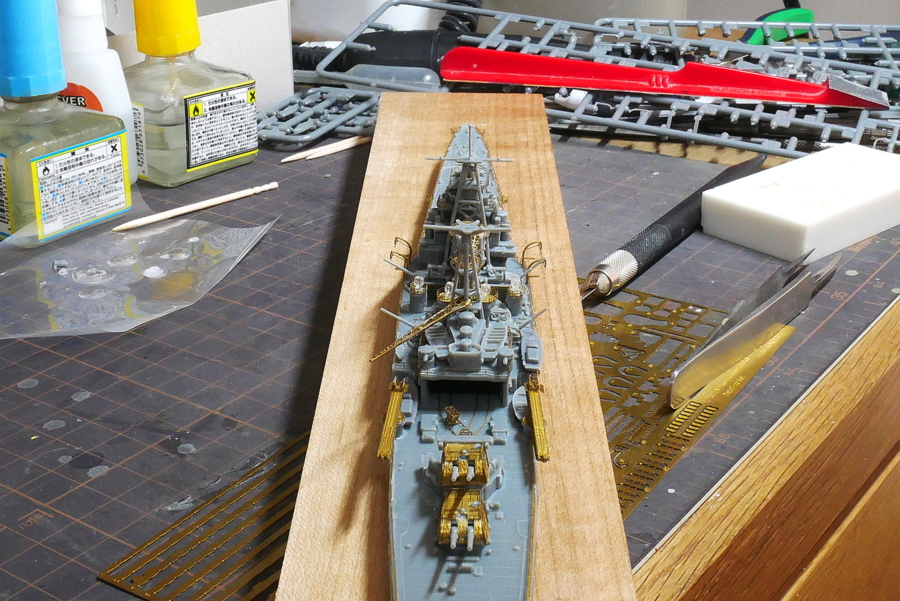
If it is off the center, such as a mast, it looks terrible when seen from the front or the back, so I tried to be in the center correctly. The crane in the back is still coming.
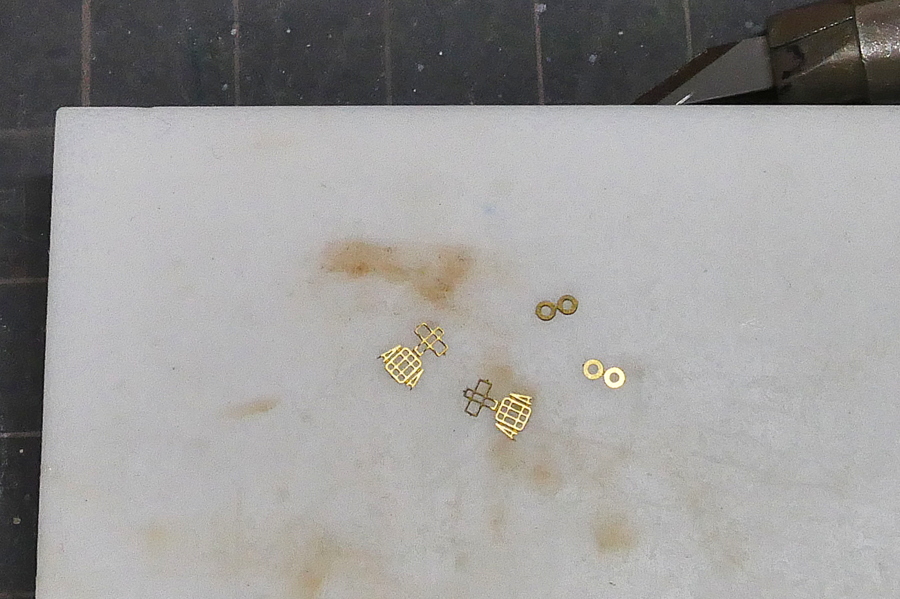
This is very fine, it’s a lifebuoy, and the frame of the metal fitting to store it. This one is much more precise than the one I used to cut the covering of the electric cord into round slices to make a lifebuoy. It’s too fine to paint.
(2021/05/27)

I use as many etched parts as possible while I struggle. The superglue came out and got dirty in various places. I want to clean it with fine sandpaper before painting. I think it’s too much adhesive.
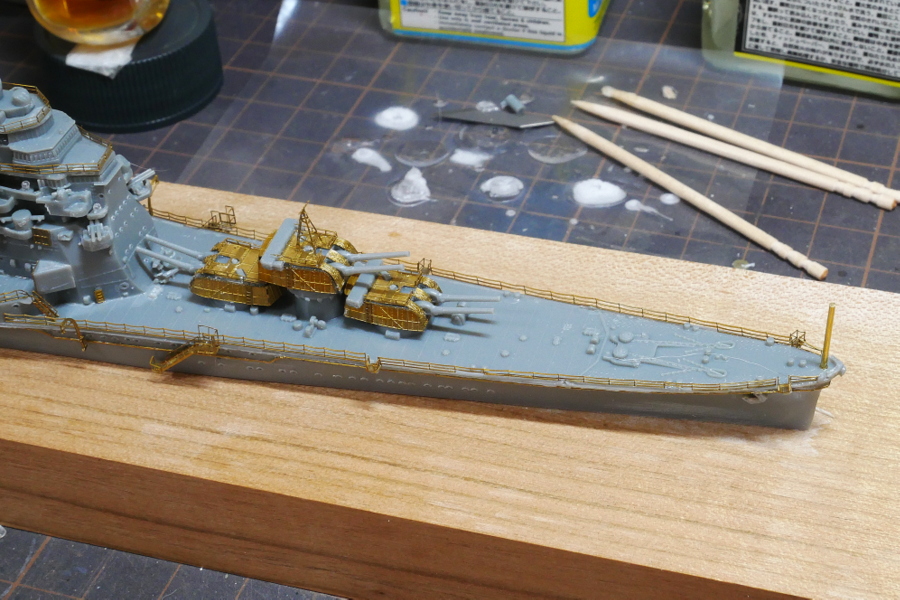
It would be too thick if I used a 1mm brass wire for the flagpole on the bow. The hull is almost finished. Maybe I should clean it a little before painting.
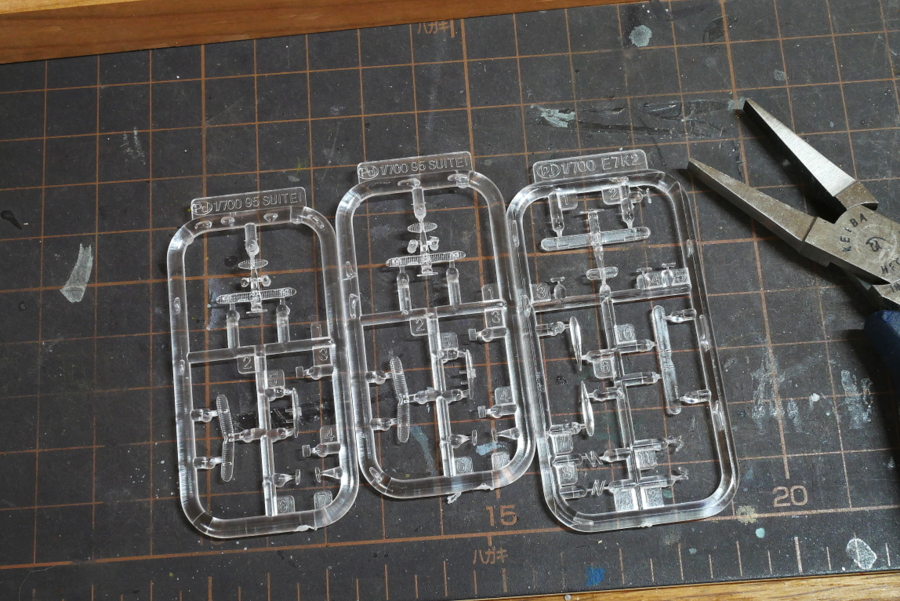
The other day, when I built the aircraft carrier Hosho, I thought I would give up. There were three double-leaf reconnaissance planes in this Chokai kit, too. It doesn’t seem to be difficult to glue because it’s made of plastic parts this time.
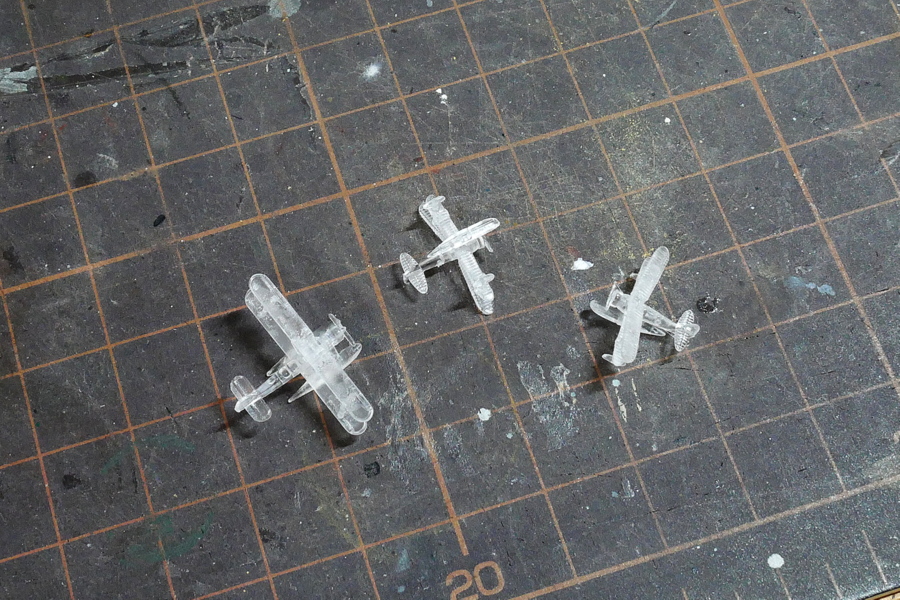
They are Type 94 and Type 95 reconnaissance planes. I made three planes in total.
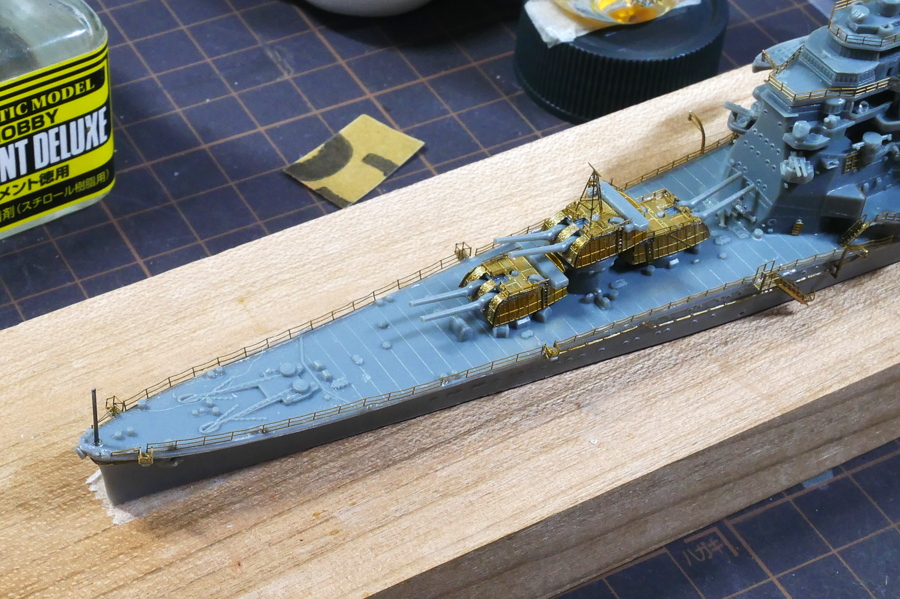
The bow and stern flagpoles have been replaced with 0.5 mm metal wires. It may still be thick, but this is just right considering the strength.
(2021/05/30)
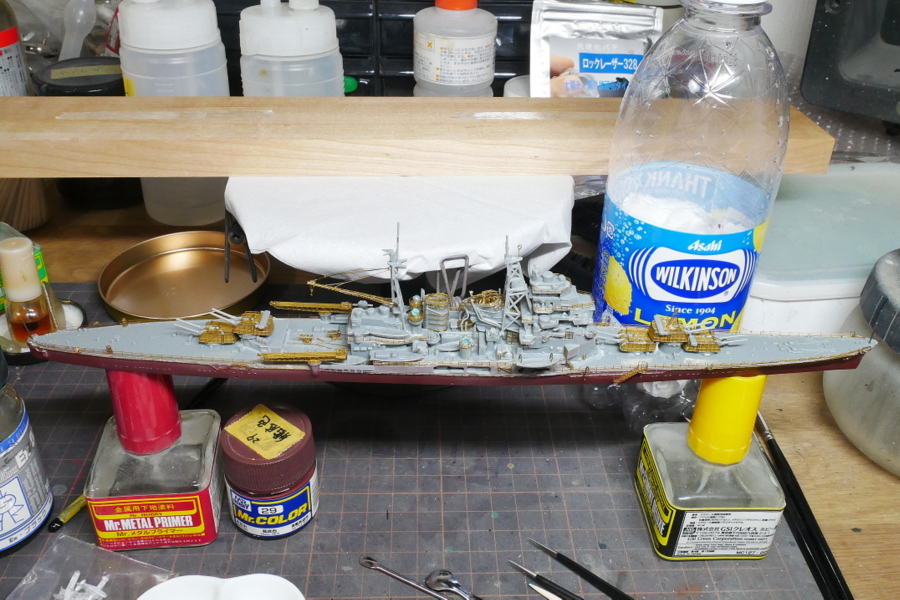
Since there were many metal parts this time, the metal primer was blown by an airbrush. I think it’s good that there is no surfacer because it’s a warship color with strong covering power. I don’t want the mold to be buried.
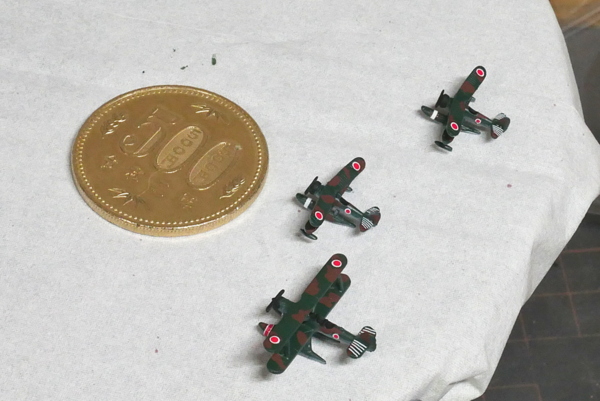
The reconnaissance plane has been completed. There were fine decals on the float and the tail.
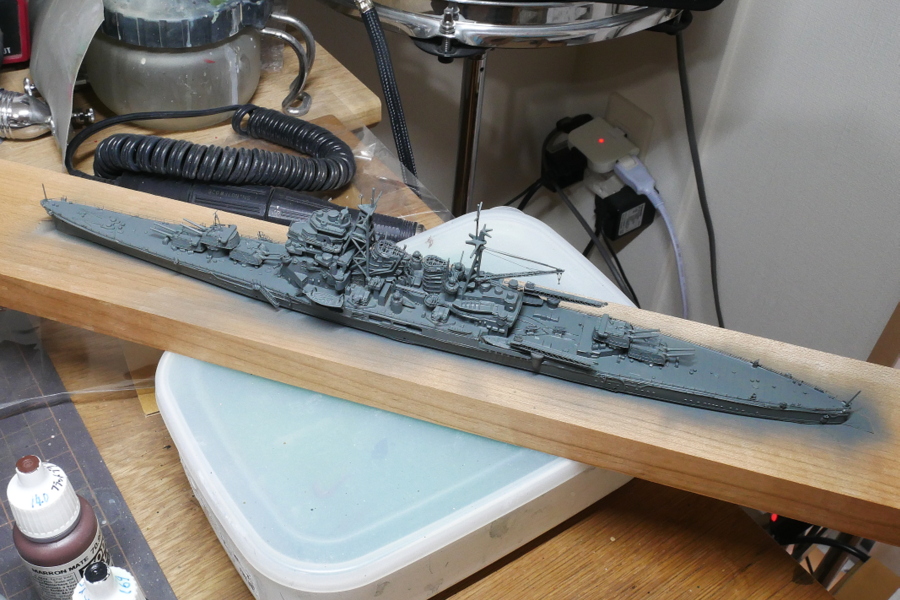
First, all of them were painted in a battleship gray color. It seems that all the difficulties in assembling until now are being filled.

The linoleum part of the heavy cruiser was finely painted using the brown color of Vallejo this time. It isn’t easy to mask the fine parts on the deck, so I think it is best to paint with a thin brush.
(2021/06/01)
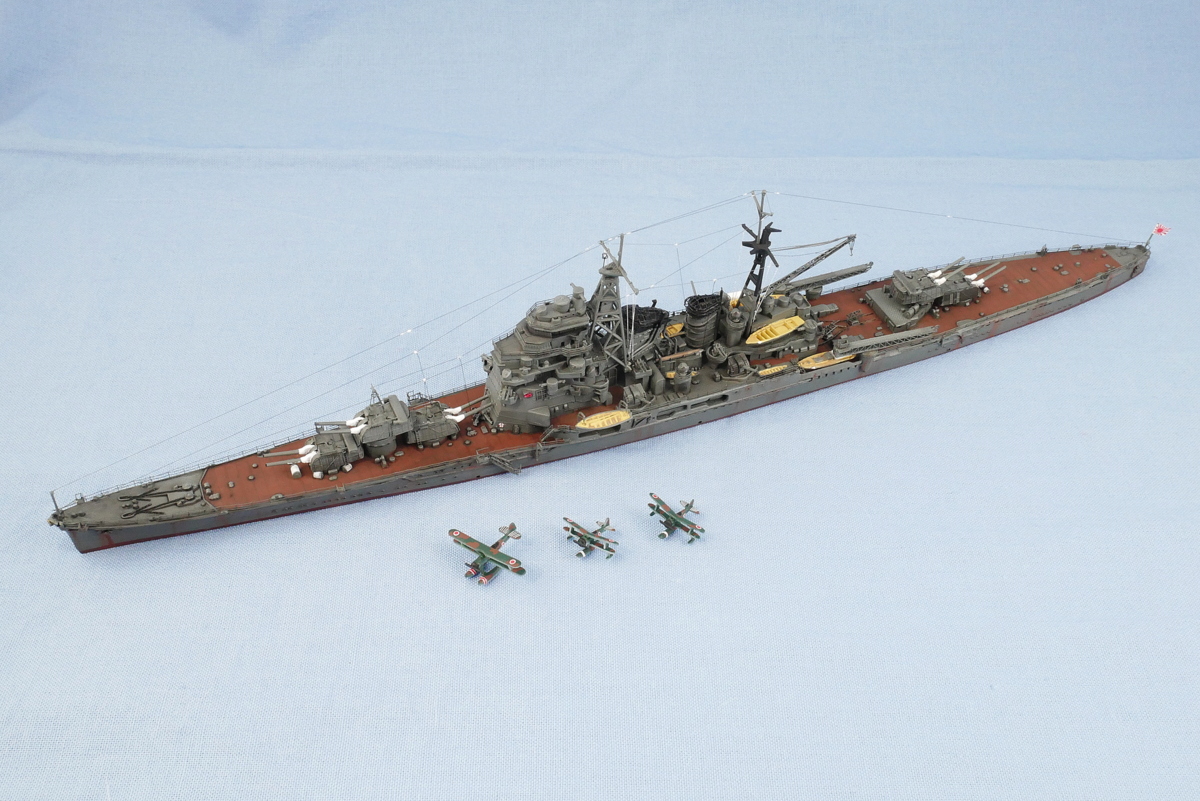
The heavy cruiser Chokai has been completed. Chokai is the 4th of Takao-class heavy cruisers. The ship’s name comes from Mount Chokai on the border of Akita and Yamagata prefectures in northern Japan. The view of the mountaintop covered with snow is breathtaking.
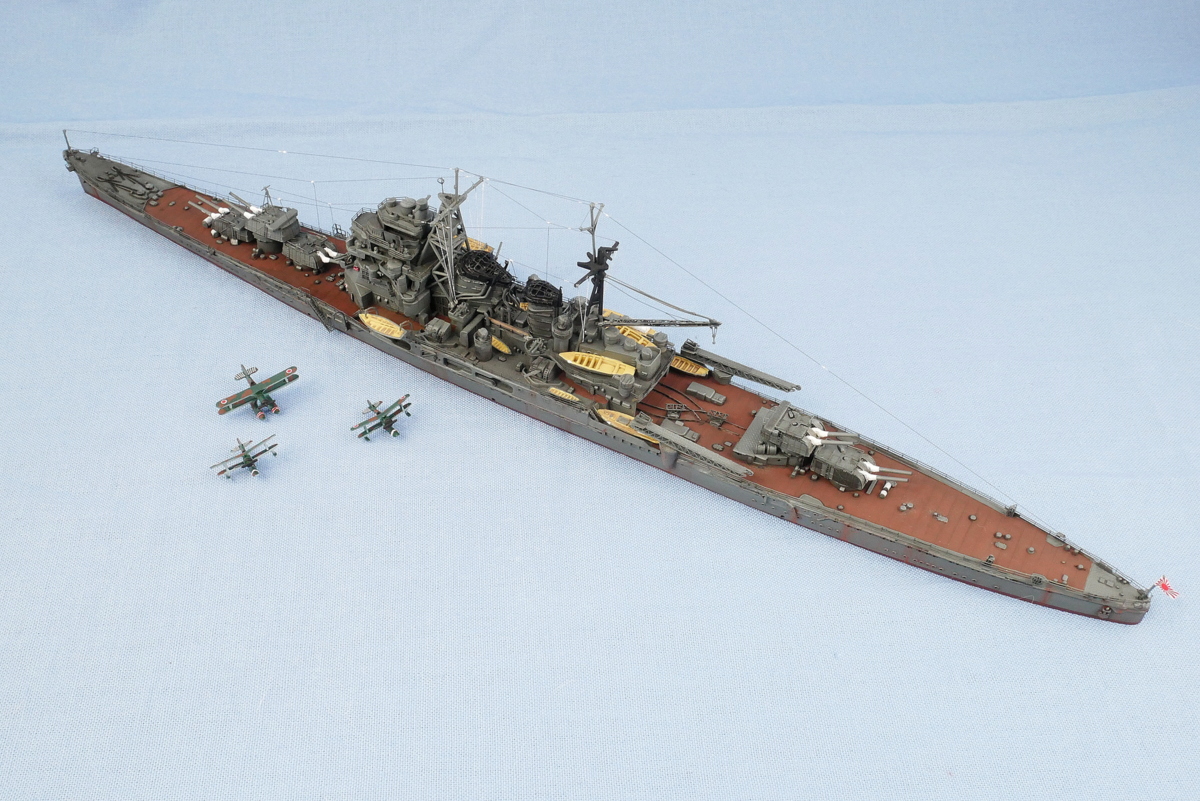
At the beginning of the Pacific War, Chokai belonged to the Fourth Squadron of the Second Fleet and participated in the capture of the Malay Peninsula and Dutch territories of Borneo, Java, and Sumatra.
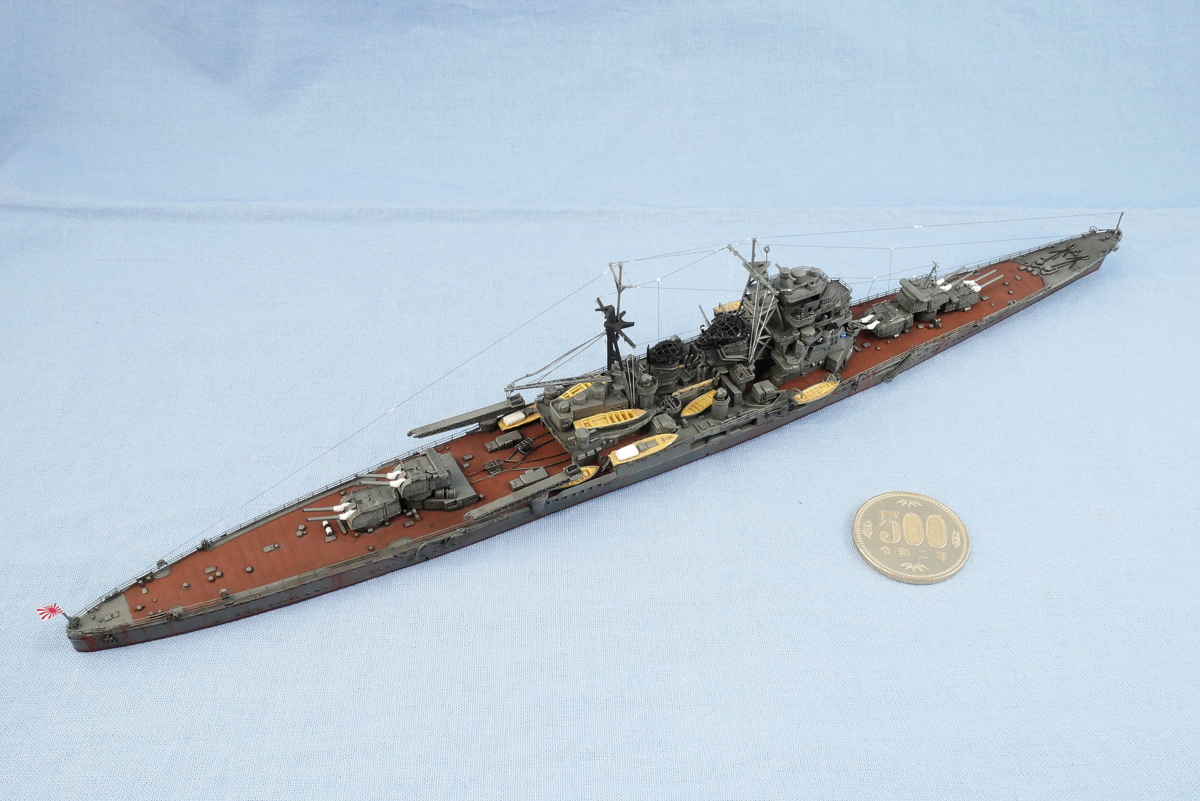
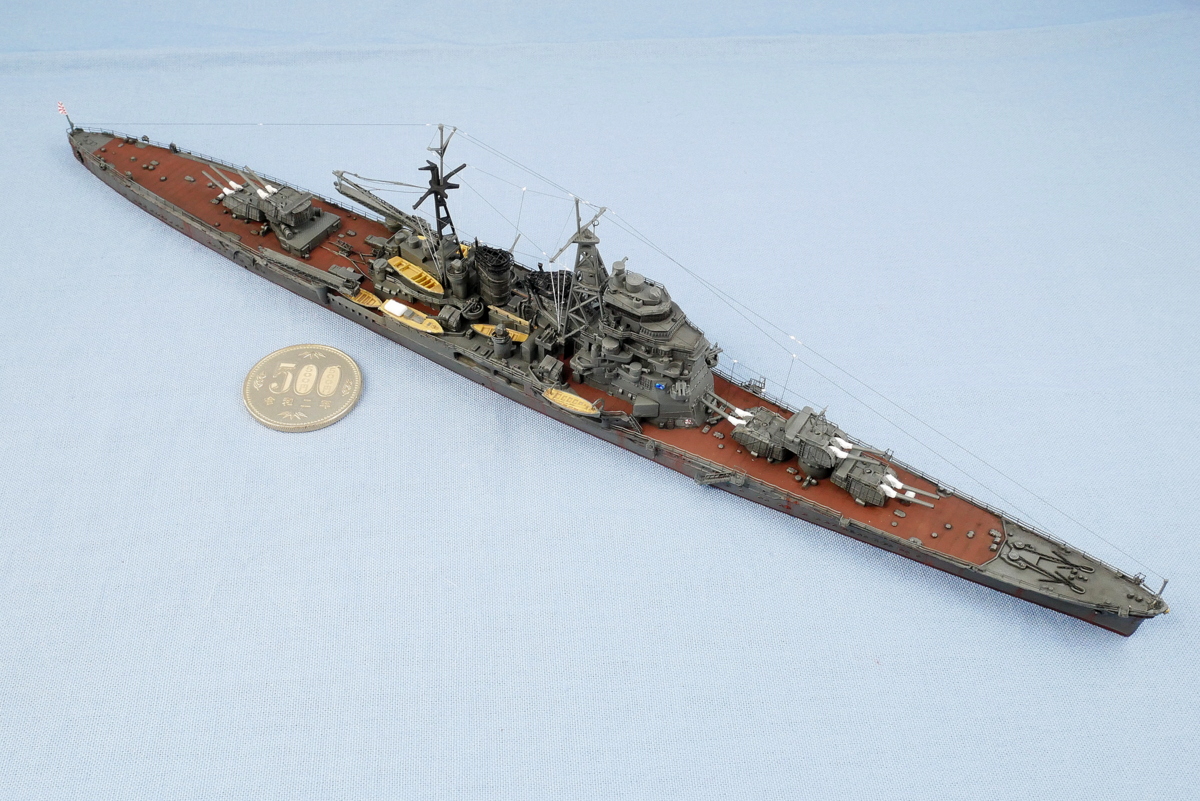
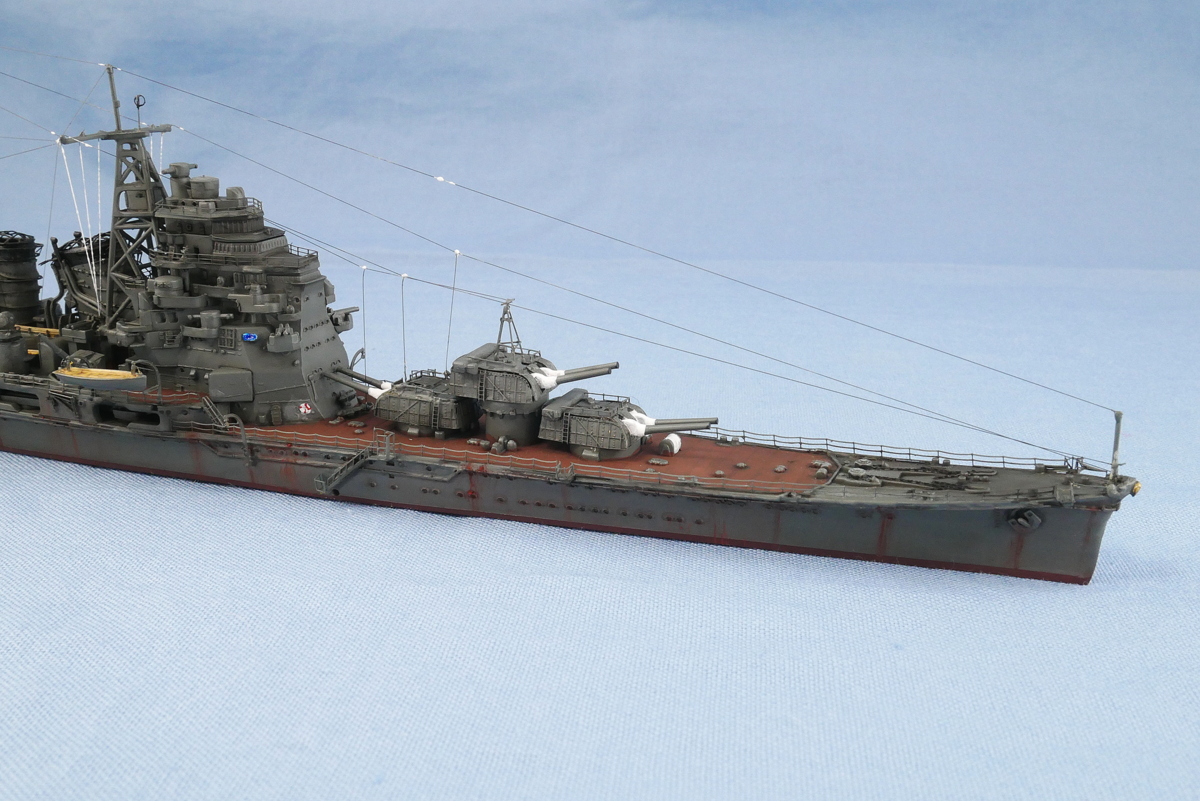
She joined the Battle of Guadalcanal in 1943. During the Battle of Leyte Gulf in October 1944, the central part of the hull was hit, and a torpedo triggered the explosion, and the rudder broke down, causing the ship to leave the front line. There is also an opinion that she was shot by mistake by the battleship Kongo. Finally, Chokai was sunk by a friendly destroyer. It is believed that some crew members had transferred to the destroyer, but the enemy’s attack soon sank the destroyer, and no one survived.
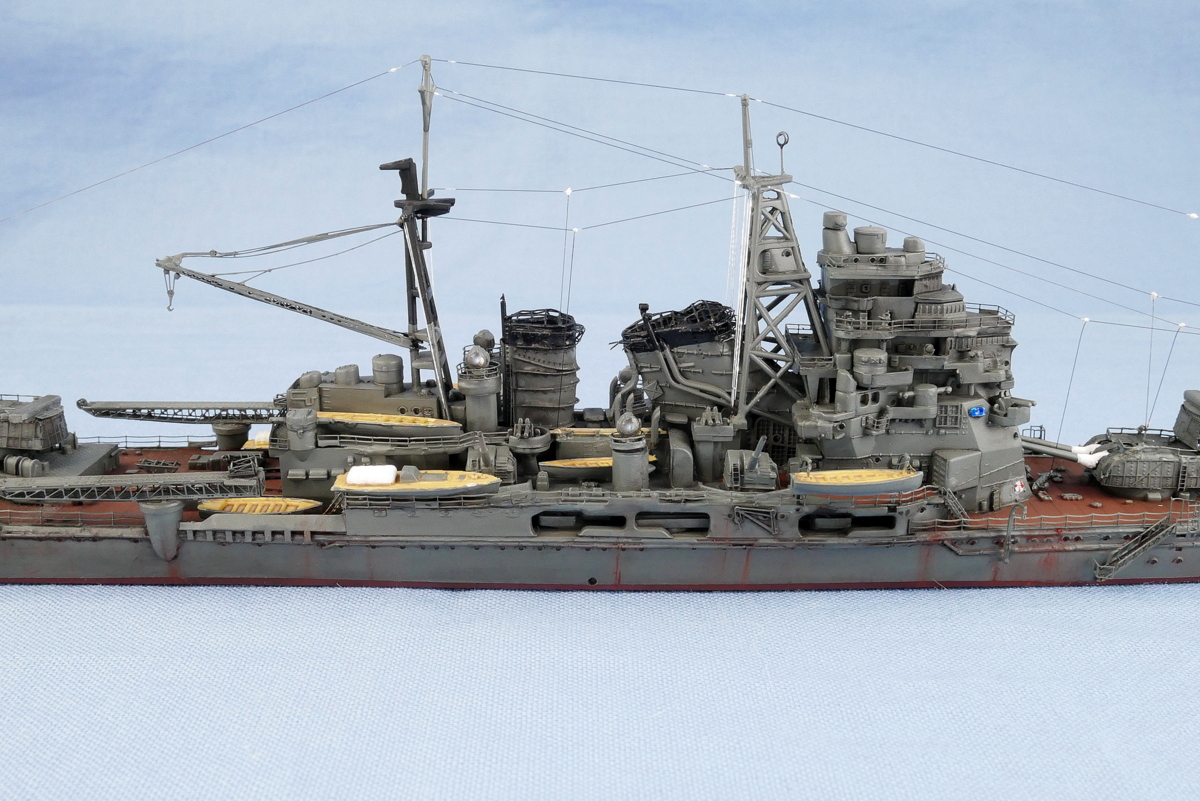
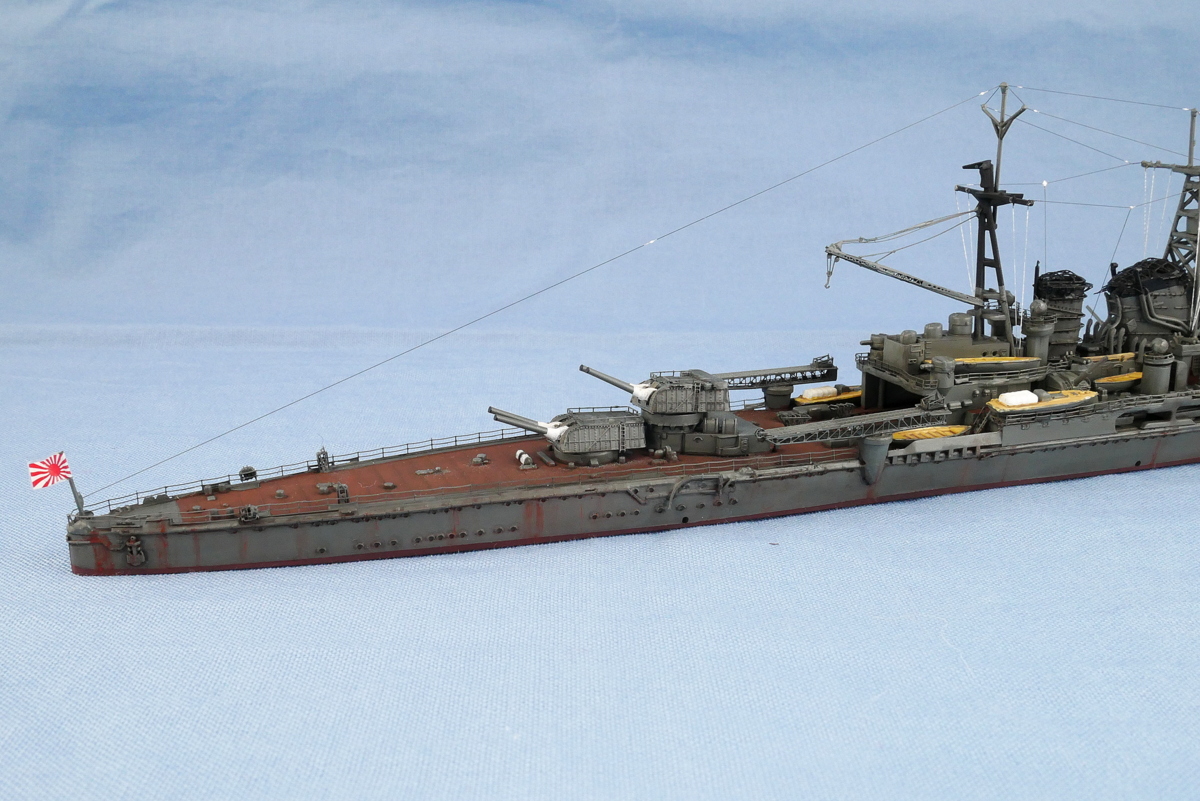
Commissioned: 30 June 1932
Displacement: 15,781 tons
Length: 203.76 m
Beam: 19.00 m
Speed: 35.5 knots
Complement: 760 (time of commission)
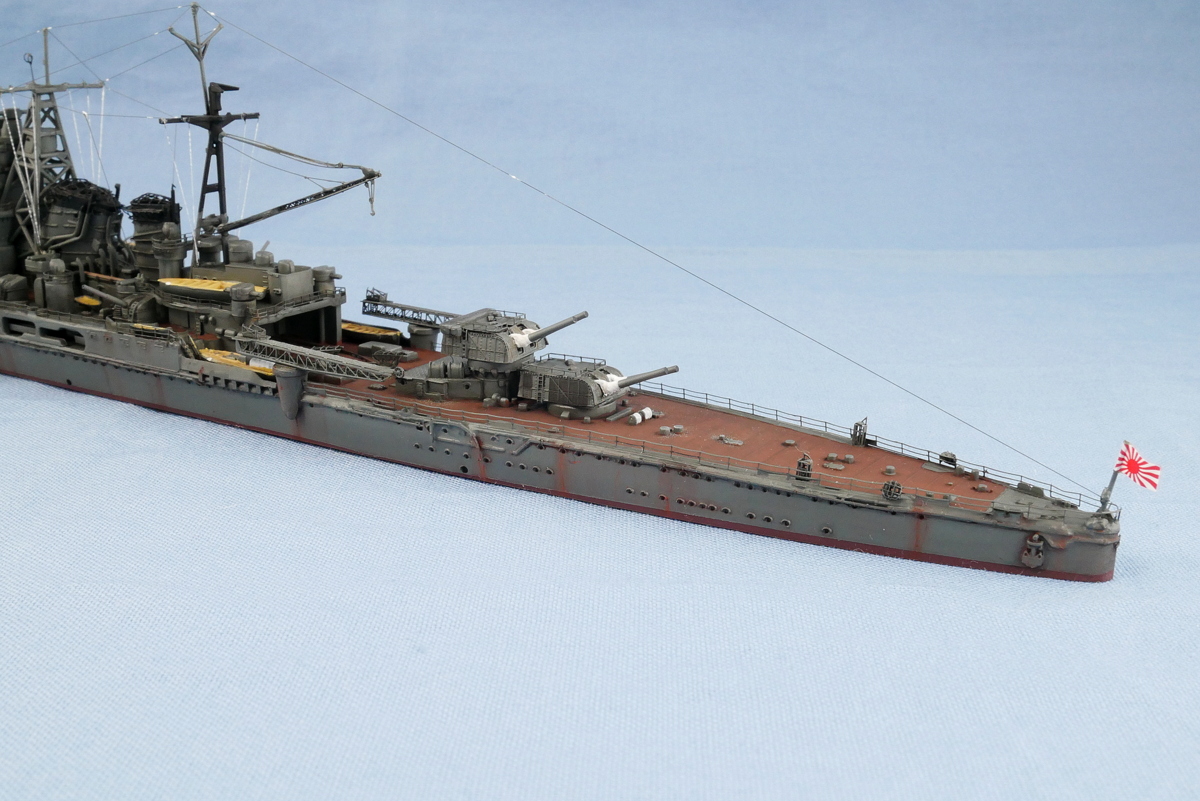
Armament: 1942
10 × 20 cm/50 3rd Year Type naval guns,
4 × Type 89 12.7 cm (5 in) guns,
8 × 61 cm tubes for the Type 93 torpedo
catapult x 2, reconnaissance seaplane x 3
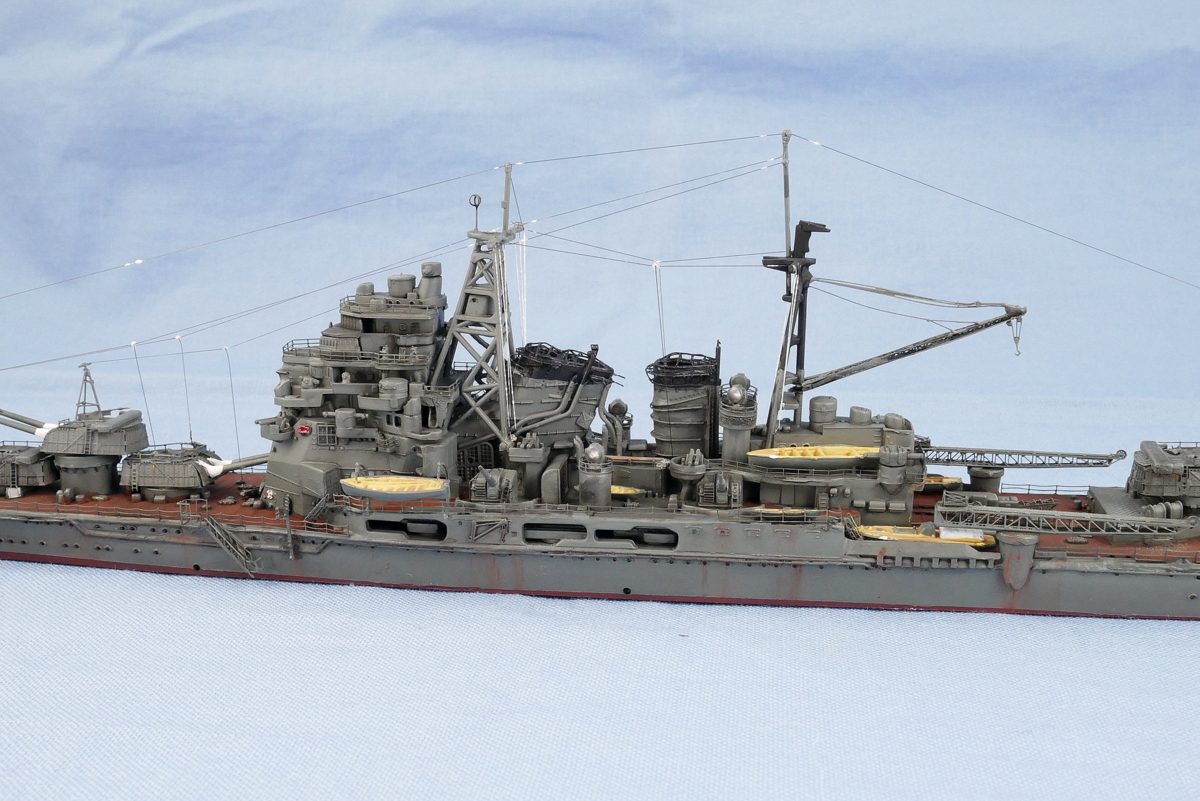

Around the time of the Battle of Leyte, just before the sinking, more anti-aircraft guns were installed in 1944.

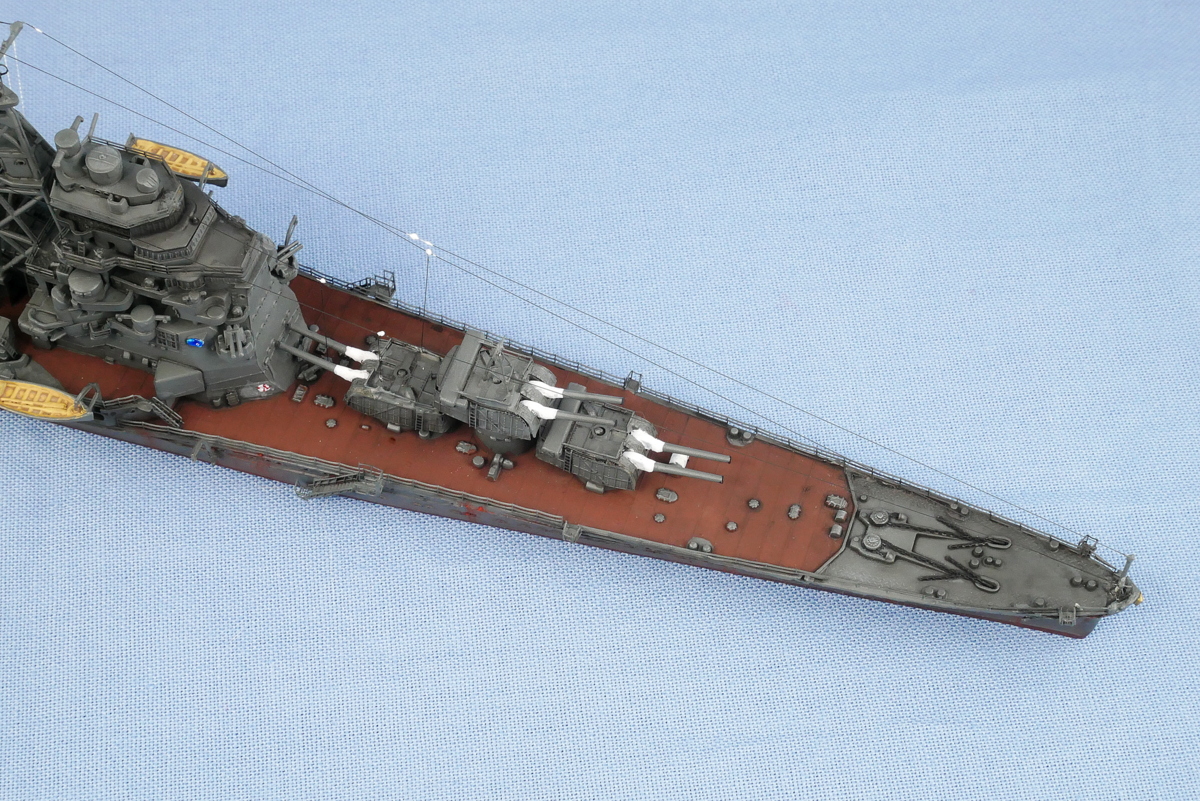
After finishing the basic painting, the hull was lightly washed with dark enamel paint to give it a light shade.

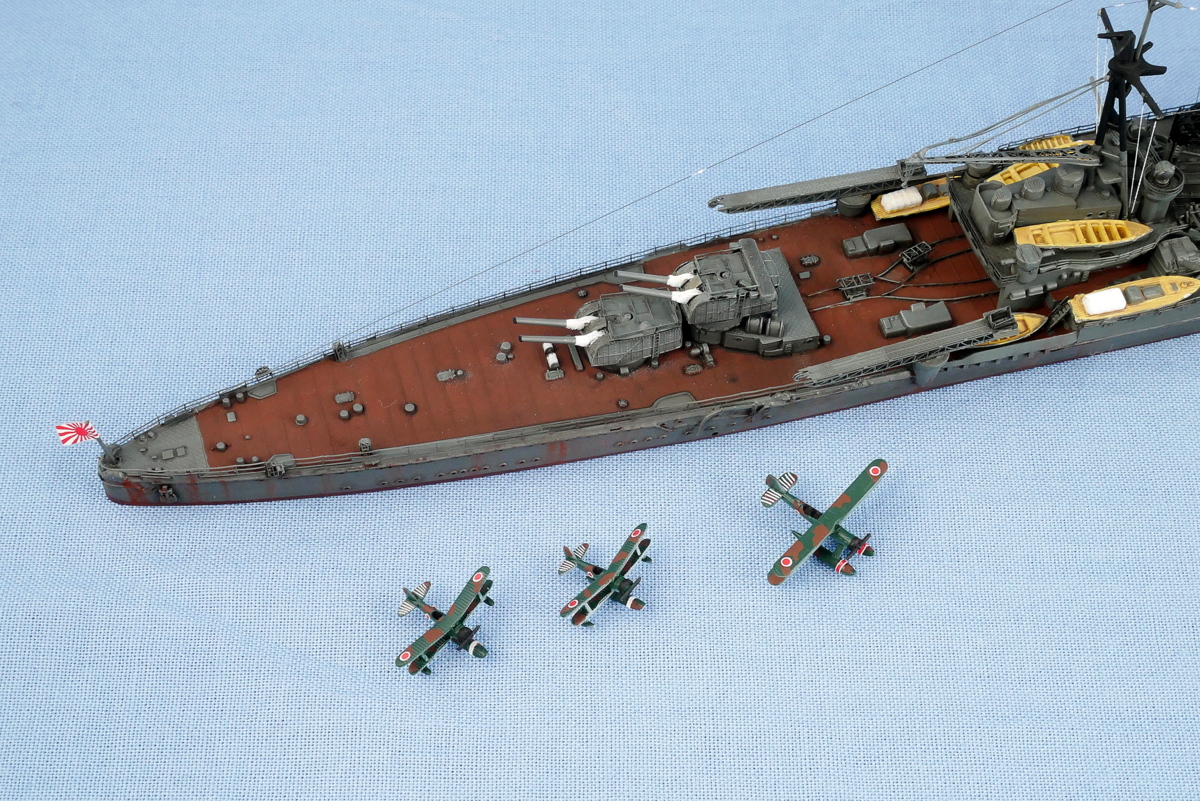
Chokai, or rather Takao-class heavy cruiser, has a lot of space on the stern deck. I guess it looks like there are hangars and catapults for airplanes in the center.
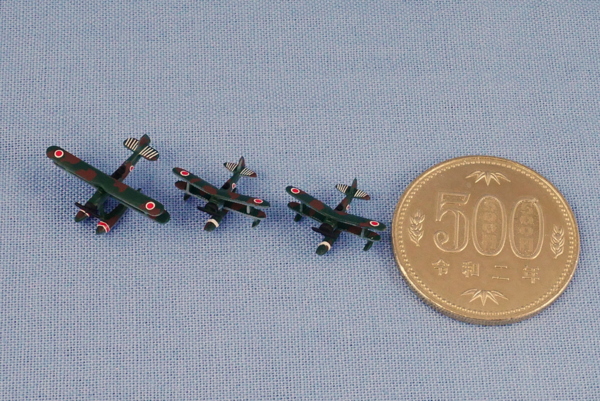
The reconnaissance plane doesn’t fit well on the catapult unless it is glued, so it is like floating on the sea.

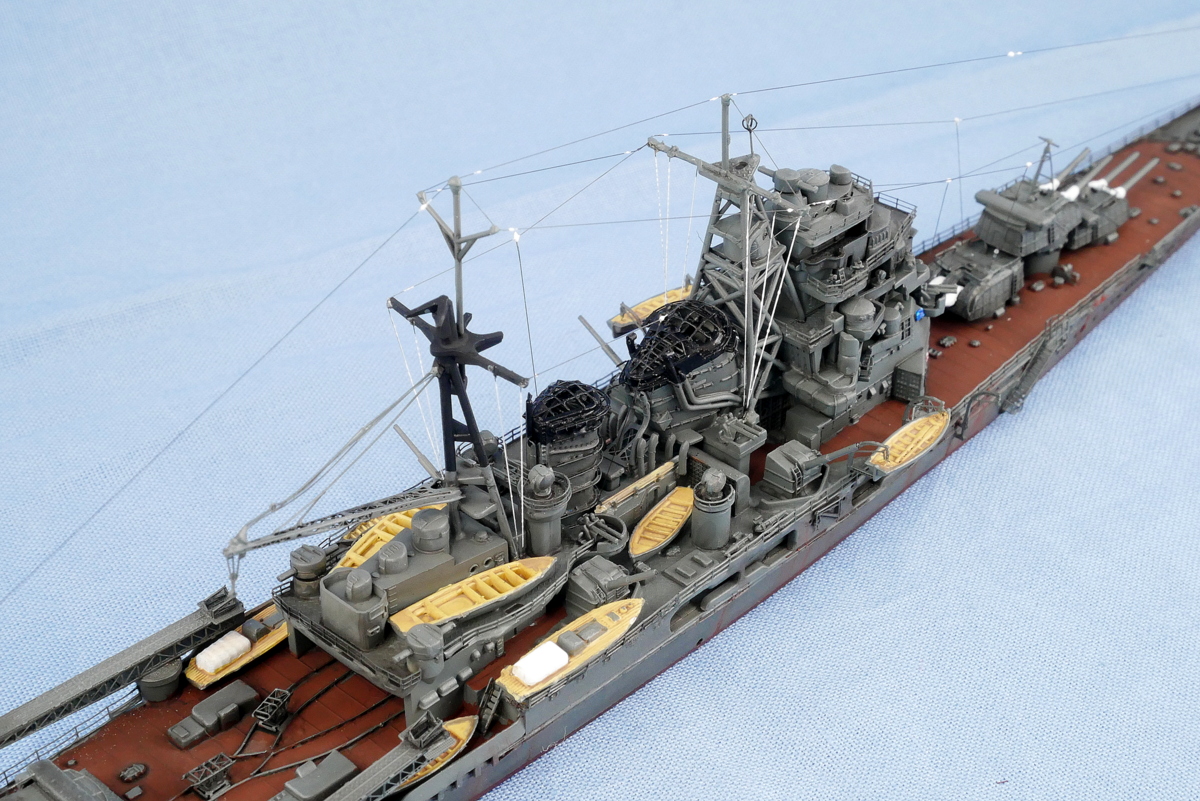
At first, I tried my best for the antenna but lost my patience. It is challenging to glue a vertical line from a long antenna on the way. I think it would be good if the atmosphere is more or less there.
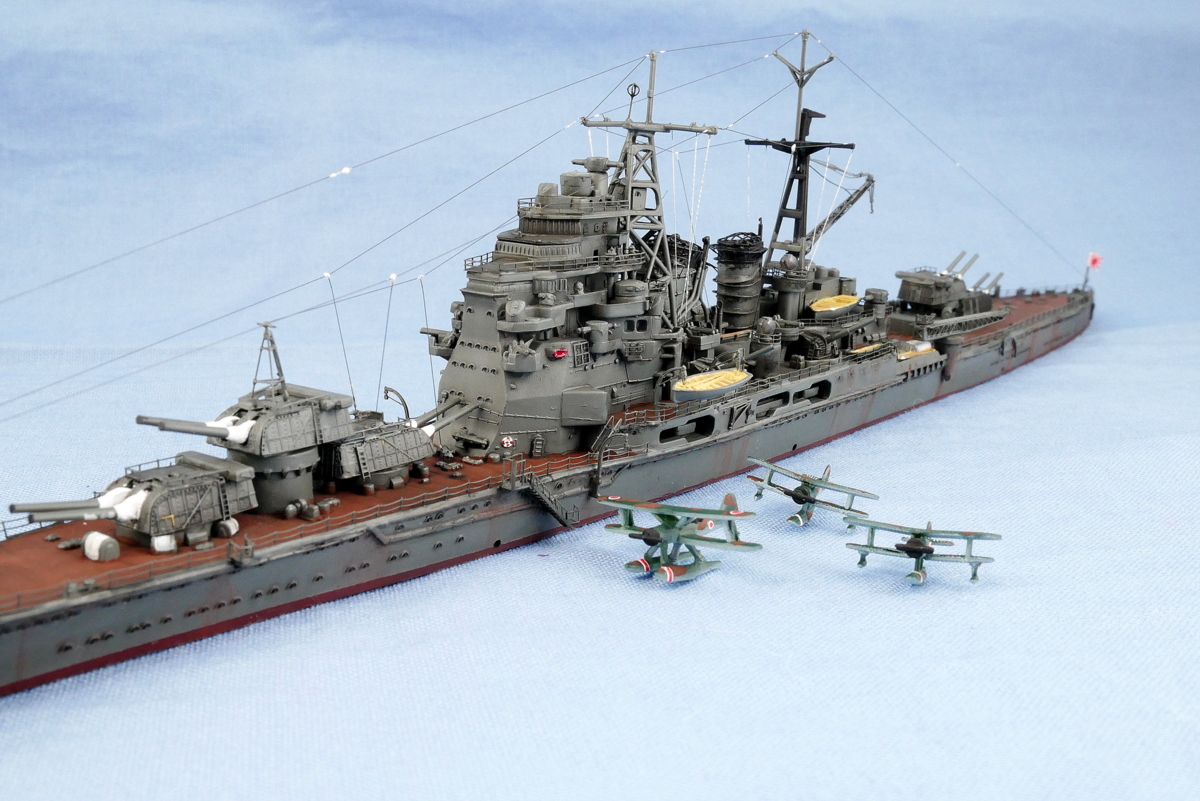
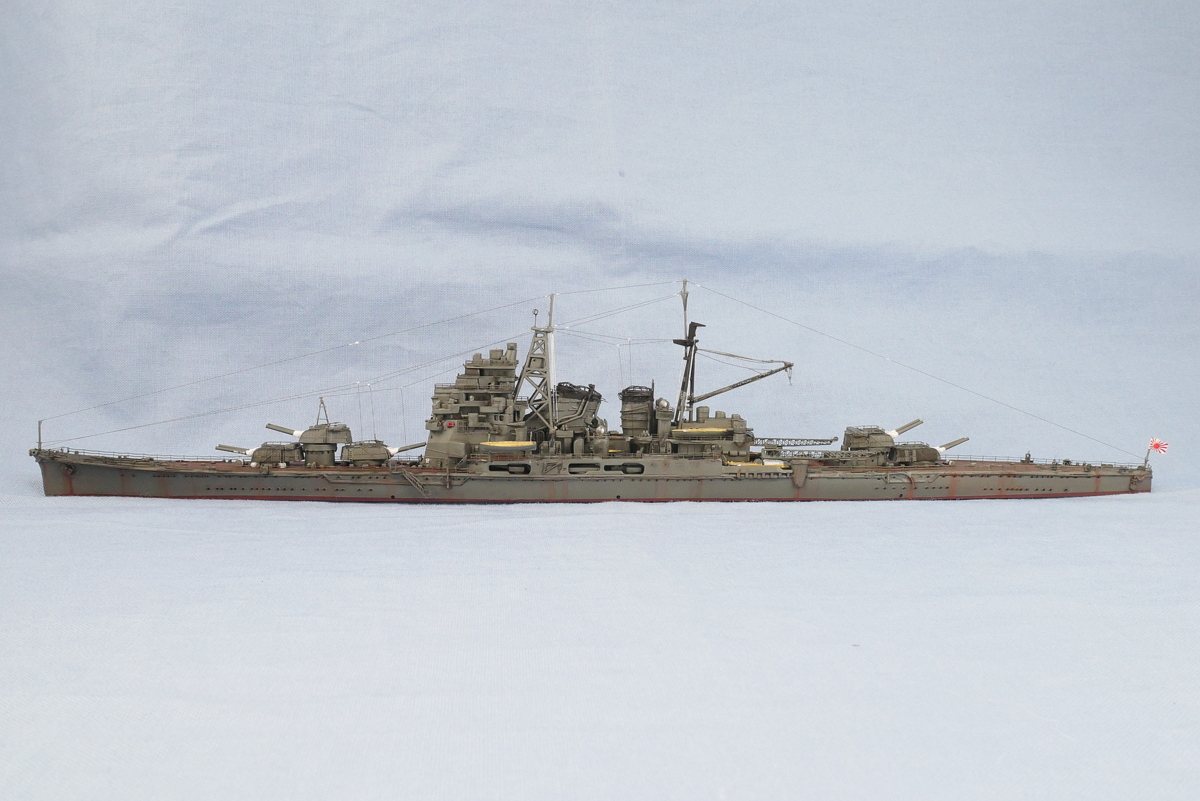
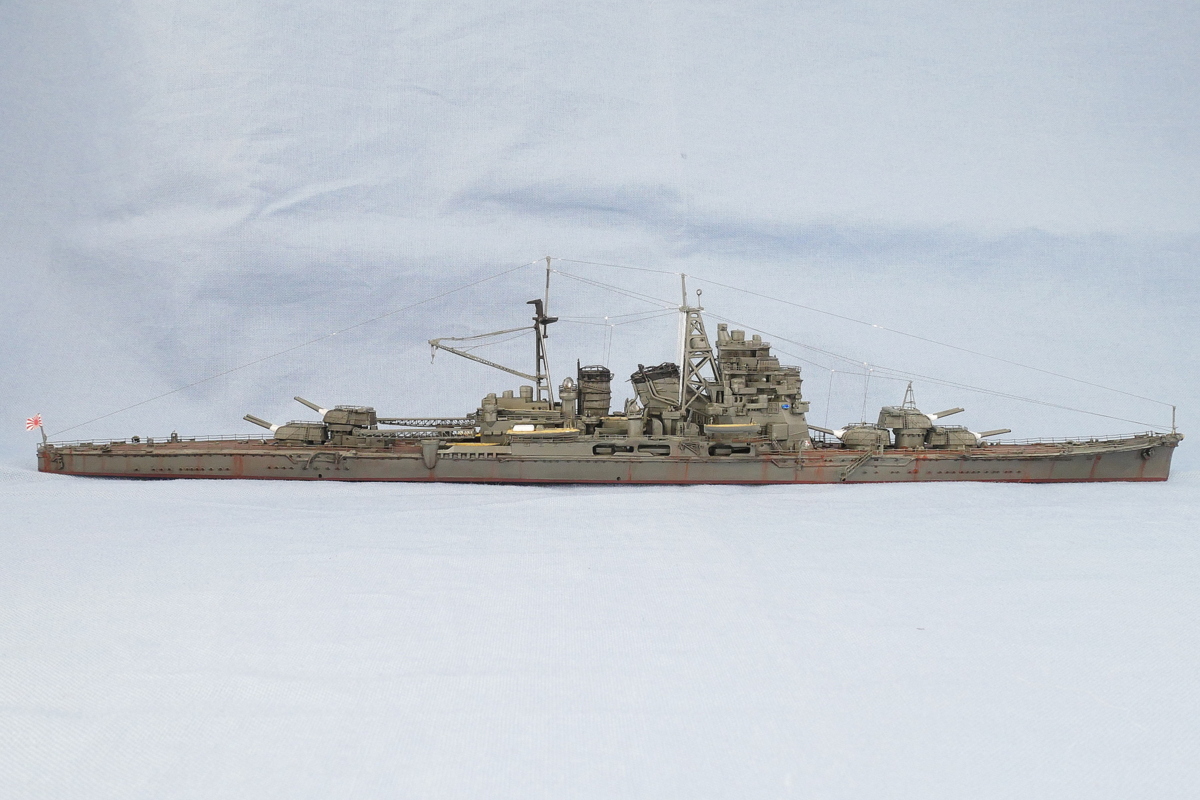
In this Fujimi Chokai kit, including its etched parts, I had a hard struggle. When I finished it, It had a sense of precision and looked fabulous. If I make weathering like rust or raindrop a little on the side of the hull, I think it will make you feel like they are working hard during the operation.
(2021/06/03)



コメント